FDA Maps Strategies to Advance Pharmaceutical Quality
Quality metrics and more domestic production aim to avoid supply disruptions and drug shortages.
Despite the pandemic, FDA has worked to maintain appropriate oversight of biopharmaceutical production activities, while also advancing strategies to encourage industry adoption of advanced manufacturing systems. The larger goals of enhanced quality production are to prevent drug shortages and ensure adequate supplies of needed medical products, as outlined in a number of studies and initiatives. Several policies and programs encourage purchasers of drug ingredients and of finished products to consider a firm’s ability to consistently produce high-quality products, an approach that fits broader federal “buy American” programs seeking to avoid supply chain problems that arise from import delays and difficulties.
Along these lines, a report from the National Academies of Sciences, Engineering and Medicine (NASEM) on strategies for preventing drug shortages and ensuring supply chain resiliency encourages healthcare systems to purchase from suppliers demonstrating superior quality and reliability. To this end, the report recommends that FDA publicly disclose the location of all manufacturing facilities that supply ingredients and components of drugs and medical products (1). Such information would include the FDA Establishment Identifier (FEI) and location of finished dosage forms, active ingredients, and excipients for drugs sold in the United States.
The annual report from the Office of Product Quality (OPQ) in the Center for Drug Evaluation and Research (CDER) similarly discusses efforts to assess manufacturing facilities and avoid drug shortages during a time of reduced onsite inspections (2). OPQ describes its greater reliance on alternative oversight tools, including the analytics reported under CDER’s Knowledge-Aided Assessment and Structured Application (KASA) drug review program and its Emerging Technology Program (ETP)—initiatives that support company adoption ofadvanced manufacturing systems and quality-evaluation methods to better ensure timely production.
And a broader February 2022 report on efforts to strengthen the US medical supply chain from the Department of Health and Human Services (HHS) highlights efforts to increase US production of raw materials and fill/finish capacity for vaccine production, as well as increased vial manufacturing, as part of HHS efforts to ensure access to vaccines, therapeutics, and diagnostic tests during the pandemic (3).
Concerns about ensuring the quality of pharmaceutical ingredients and products made overseas also is reflected in Congressional efforts to strengthen FDA’s foreign inspection program. The recently approved $6 billion FDA budget for the 2022 fiscal year calls for the agency to conduct real-time, unannounced plant inspections in foreign countries and instructs FDA to spend $5 million of its added funding on hiring additional foreign-based investigators for this purpose (4). Because of logistical difficulties in conducting surprise inspections overseas, FDA officials plan an analysis that compares the impact of announced vs. unannounced foreign site visits to better understand the value of such efforts.
Seeking new quality metrics
Meanwhile, FDA continues to devise a program for manufacturers to collect and report a slate of measures designed to indicate quality production. The agency recently outlined a revised approach for this initiative, which builds on earlier efforts to devise a system for companies to measure and track data on manufacturing process performance and pharmaceutical quality systems effectiveness.
The new plan calls for manufacturers to report data on the proportion of manufacturing lots accepted within a certain time period, effectiveness of corrective action and prevention action (CAPA) activities, proportion of laboratory tests completed on schedule, and shipments of products delivered correctly and on time, as outlined in a Federal Register notice published March 9, 2022 (5).
This proposal aims to address strong industry opposition to FDA efforts in 2015 and 2016 to establish such a quality measurement program. The underlying rationale is that by collecting data on manufacturing operations and product quality, companies can help FDA—and themselves—identify risk factors likely to lead to shut-downs and shortages. Industry strongly objected to FDA’s initial data submission plan, prompting the agency to start over and collaborate with academics and industry in conducting pilot programs to assess the impact on companies voluntarily providing quality management maturity (QMM) data.
At the same time, the pandemic focused broader government and public attention on how drug manufacturing and quality operations affect national security and public health.
FDA’s new performance metrics system aims to offer more flexibility for manufacturers to report data on key quality indicators. The agency asks manufacturers to weigh in by June 7, 2022 on the plan, particularly whether each establishment should report these data, how contract manufacturers should be measured, the process for revising metric reporting in the future, and the importance of trying to measure the “quality culture” of a company.
References
- NASEM et al., Building Resilience into the Nation’s Medical Product Supply Chains, The National Academies Press, Washington, DC, 2022.
- FDA, Center for Drug Evaluation and Research, Office of Pharmaceutical Quality, 2021 Annual Report, Assuring quality medicines are available to the American public, February 2022.
- ASPR, Public Health Supply Chain
and Industrial Base One-Year Report, February 2022. - US House of Representatives, Bills-117RCP35 JES Division A, Division A–Agriculture, Rural Development, Food and Drug Administration, and Related Appropriations Act, 2022, Congressional Directives.
- FDA, Federal Register, Vol. 87, No. 46, March 9, 2022.
About the author
Jill Wechsler is Washington editor for BioPharm International.
Article details
BioPharm International
Volume 35, Number 4
April 2022
Pages: 8–9
Citation
When referring to this article, please cite it as. J. Wechsler, “FDA Maps Strategies to Advance Pharmaceutical Quality,” BioPharm International 35 (4) (2022).
